
Stone Washington
The Legend of Franck Muller: Master of Complications
By Stone Washington

"For the man, the watch is the single greatest self-expressive object he wears; it is his jewel and to be without a watch, for many men, is to be totally undressed."
"The greatest factor for us in relation to how slow or how quick time passes has to do with the enjoyment of time."
~Franck Muller
The origins of time and horology
Timekeeping and the basis of time is the core element in tracking human existence and universal events. It is the measurement of history: past, present, and future, establishing an indefinite precedent behind human progression in the World. At the center of time is the invention of the watch, the most useful and versatile method of accurately keeping time. Watches have undergone multiple transformations and upgrades since being officially conceived in the 16th century and have been derived from a series of antiquated methods of timekeeping. Below is a brief timeline containing many of the greatest innovations in modern timekeeping, from antiquity to modern day: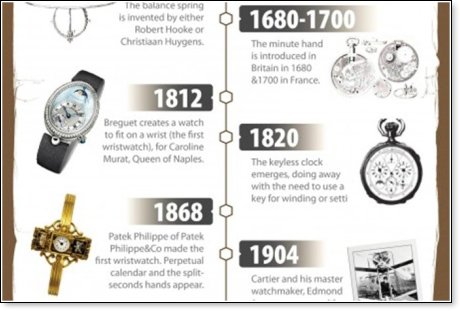
Watches act as portable spring-driven clocks, which were invented prior during the 15th century. Watches utilize a complex system of interconnected gears propelled by winding a mainspring, which transfers power to an oscillating balance wheel. The watch's escapement then releases the inner-wheels to inch forward a small amount during every swing of the balance wheel. The mainspring acts as the power source of the watch, the power of which is disseminated by the escapement which regulates every swing of the balance wheel; an advanced pendulum.
Despite the many innovative achievements and technological breakthroughs in timekeeping, no other watch company has achieved the greatest level of complications in watchmaking as Swiss watchmaker Franck Muller (1958 – ). Following the Quartz crisis, a period in the 1970's that led to economic upheavals and layoffs in mechanical watchmaking, Franck Mueller launched a company that would revolutionize modern watchmaking and breath newfound life into the elegant art of Swiss timekeeping. Muller, along with inventor Pierre Michel-Golay and Co-founder Vartan Sirmakes would introduce a new realm of timekeeping that broke the monolithic boundaries of tracing time for centuries, creating the first series of unprecedented complications in watchmaking.
This article will describe Franck Muller's greatest inventions and universal impact on essence of timekeeping, tracing inspiration from the leading watch manufactures: Patek Philipe, Audemars Piguet, Breguet and others, to create truly transformative timepieces that defy the norms of reality. Even today, Muller serves as an ambassador to inspiring those who think critically and defy the artificial boundaries of possibility, going above and beyond what is expected.
Biography: Franck Muller and the "Purity of Existence"
Franck Muller: a showman, technical prodigy, impresario and elusive genius was born in 1958 to an Italian mother and Swiss father. Muller was infused with a DNA of a masterful design acumen, aesthetic bravado and admiration for scientific invention that made him the ideal Italian watchmaker, combined with the dedicated precision and respect for traditional values that comprise the root of Swiss watch culture. Franck is prominent in his ability to reach back into the historic origins of watchmaking and from this create an all-new relevance to the mythical language of complications. His company has made an art out of reinventing the value of a watch's essence; its gearwheels, balance wheels, hairsprings, etc. for a new contemporary world. "What is clear is that without Franck Muller, watchmaking would not exist at the same level of cultural relevance as it does today" says watchmaking legend Phillipe Dufour.
Franck Muller often struggled in grade school, desperately seeking to gain his Father's approval. This until Muller approached his father one day and vowed to enter watchmaking school, declaring, "Father, I will finish, and when I graduate, it will be as the top student." Muller fulfilled his vow when, in 1977, at the age of 19, he graduated from watchmaking school in an accelerated program with top honors. "It was only when I became a watchmaker that I discovered what I was talented at, what God had put me on earth to do. And from the day I stepped into watchmaking school, I never scored anything less than a perfect mark." Unfortunately, Muller's father passed away soon after he was proud of his son's achievement.
In his practice, Muller is confounded by how sophisticated a watch operates, seeing as how when you break it down component by component, wheels, springs and all, its just pieces of metal. It is a miracle of ingenuity that a watch can operate at all and function flawlessly 24 hours a day, 365 days a year; creating something truly incredible. Almost immediately after leaving watch school, Muller had the dream of creating his own brand, seeking to "elevate this language of watchmaking to an even higher level of expression," he says, "I wanted to create an evolution that would unveil hidden truths about the way human beings express time." Muller would gain his first big break when he was provided a Rolex as a gift, but called the watch too simple upon wearing it. So, he decided to transform the watch into a perpetual calendar with retrograde indications, linear displays on the watch that reveal functions like: day/night indications and power reserve. Upon completing it, Muller signed the watch "Rolex and Franck Muller" and presented it to the top Rolex engineers who, after several days, ultimately rejected it because they abided by the Rolex philosophy was to produce the simplest but most reliable watch possible.
But Muller would capitalize on this venture by selling the watch for 10,000 Swiss francs to a gentleman named Francis Meyer, the son of an extraordinary pocket watch collector. The watch would break the record for being the most expensive steel watch sold just two years after Muller had sold it, passed onto an Italian distributer of watches in Monaco for 400,000 Swiss francs.
"The beginning of my story in watchmaking coincided precisely with the end of traditional high watchmaking," Franck explains, "previous to the modern age, watches were made almost entirely by hand. The designs for the watches began entirely within the minds of the watchmakers." There were no complex computer simulations to test complicated mechanisms, creating an enormous risk for each watch made. This until the watchmaking world was reinvented following the Quartz crisis in the 1970s. While computers helped create complex parts and allowed for rapid prototyping, it also took something away from watchmaking: it robbed a bit of the inexpressible human spirit and diminished in some way the measure of soul that went into each watch. The Quartz crisis counteracted the time-honored tradition of the watchmaker, who pitted his intellect, manual dexterity and creative internal fortitude against the unchanging laws of physics. Man could no longer bend time to his will in an age of automation.
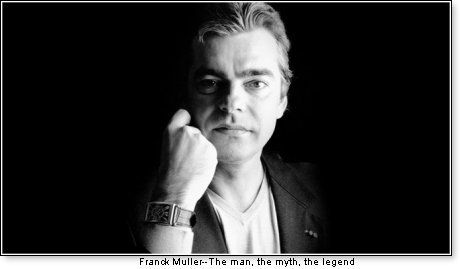
"Every great watchmaker had his secrets, his method to make time obey him, to activate the heartbeat inside the watch," according to Muller, "my secret was that I could repeat what I saw quite eastly from memory." Laboring under the tutelage of Svend Anderson, Muller recounts how strict his master was when he would examine Muller's mechanisms modeled after Anderson's work, examining it with a 3xloupe to spot any imperfections. If there was even the slightest, he would very strictly throw the part away. Under Anderson, Muller labored tirelessly, absorbing rich information and plunging into the past to see how old masters solved the age-old riddles of measuring time.
Franck would reach deep into horology's past and transport one of its most technically sophisticated innovations into his first wristwatch collection. This came through the reinvention of the tourbillion for wristwatches by Muller, an invention first produced by A. L. Breguet to improve precision in watchmaking. While Breguet is one of the oldest and greatest watch manufacturers, Muller surpassed the company's conventionality when turning the tourbillion into a device that captures and expresses emotion. Patented in 1801, the tourbillion places all the complex regulating components of the watch – including the parts that form its: escapement, hairspring, and balance wheel – inside a cage that rotated on its own axis. This cage averaged out the positional errors including how gravity inaccurately affects the movement of the hairspring when a pocket watch is left in the vertical position.
"Today, these watches are more like works of art which demonstrate what is possible through human craftsmanship, and engage the user on the emotional level," Muller states, "People were living life to the fullest and they wanted new symbols of success, and the tourbillion was it." In devising his company, Muller embarked on creating something wholly unique that the world hadn't seen before; something daring but also horologically legitimate in the eyes of the most refined collector. Muller went on to create the World's first minute-repeater tourbillion, a complicated mechanism capable of chiming the hours and minutes in a watch, eventually moving to create something even more difficult: the world's first tourbillion with split-seconds chronograph.
Muller, along with his branding associate Vartan Sirmakes and watchmaker Pierre-Michel Golay went on to dominate the world of watchmaking, from the company's rise in 1984 through the 1990s. Some of its most famous early adaptors of the brand were: Gianni Versace, Elton John, and Jackie Chan. In the final section, we will look at some of the greatest horological breakthroughs that Muller made in watchmaking.

Mueller's Revolutionary Complications
The Giga Tourbillion – Dubbed "The Colossus of Genthod" after "The Colossus of Rhodes" statue, one of the Seven Wonders of the Ancient World that was made in honor of the unconquerable city of Rhodes. This, when Alexander the Great's three greatest generals: Ptolemy, Seleucus and Antigous tried to and failed to besiege the city for a year. The "Colossus of Genthod" is a living testament to the daring courage and technical mightiness of the most successfully independent watchmaker in contemporary horology. So why the name Giga Tourbillion? This due to the entire bottom half of the watch being dominated by a tourbillion regulator so large that "the arms of its cage threatened to block out the rays of the sun," according to Vartan Sirmakes. "You can literally imagine gravity, which the tourbillion was created to defeat, whimpering like a scared dog in deference to the sheer monumentality of the Giga Tourbillion's 20 mm-diameter cage. Oscillating within this cage is a golden behemoth of a balance wheel measuring 16mm in diameter," declares Jean-Pierre Golay, "we are really at the limit of what we are capable of creating, even with the most advanced technology possible."
Crazy Hours – At first glance, the "Crazy Hours" watch appears to be a random jumble of colorful numbers, all in different places than they should be. But there is a method to the madness behind Mueller's design, as the hour hands leap around the dial in accordance to the set time (from 1-12) but jump five places instead of one to the next hour, while the minute hand functions normally. To simply call Crazy Hours a watch would be a disservice, as it is more of an artform; a vehicle for emotional expression and statement of personal philosophy. "Time was an invention of man to organize society so that social discourse and business could take place," Muller explains, "but we've become so encoded that we are moving mindlessly from one moment to the next, never reveling in the present to truly enjoy the experience. Crazy Hours had to be a statement that you could do what you want, whenever you want. In Crazy Hours there appears to be no sense as to what hours come next, and so, you are compelled to focus on the moment you are in." It is a peculiar watch meant to abstract, deconstruct, and reconfigure time with the intent to shock and delight the owner.
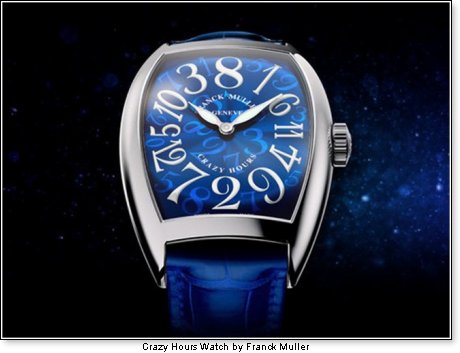
Master Banker – As Muller's brand began to grow, one of the greatest challenges he faced was being able to suit the needs of the contemporary consumer. The modern businessman or traveler is constantly shifting time zones and going from one place to another. Muller dreamed of a watch that acted as a horological Prometheus, bringing light to darkness and order to chaos. In an objective to illuminate the world, Franck Muller devised one of his most legendary timepieces: the Master Banker. Muller realized the idea through a close banker friend of his, Paul Tange, who explained his philosophy for modern business thusly, "The world has changed forever. When I wake up and I look at my watch, I want to immediately know when the market opens. Because the time it takes me to figure out the time, I could have made or lost a fortune," Tange states. After a great deal of planning, Muller devised a watch that harnessed three time zones in one, capable of telling the time in other cities across the World. Whether in New York, London, or Tokyo, the wearer is able to adjust the time befitting of a busy global schedule.
Secret Hours – Muller now delves into the human psyche to uncover truths about the way human beings perceive time. Imagine a watch that at first glance seems to be mired in contradiction; stuck in an immovable position with both the hours and minutes hands locked at 12 o'clock while the seconds hands continuously move as if the watch is under power. But the trick to this watch is that it only provides you the time when you feel like knowing it. Simply activate the pusher on the crown and the watch hands immediately jump to the correct time. Muller sought to create a watch that provides you with the proper time when you need to know it, while at the same time not imposing the burdensome reminder of continuous time passing by. "It is the only watch a civilized and truly elegant man should wear on his vacation," Mueller states. The watch is extraordinarily complicated from within, having two-split seconds chronograph heart cams that are attached to the respective hour and minute wheels, allowing time to be constantly traced by the watch while the hands instantaneously leap to the proper time without skipping a beat.
The Revolution 3-1 – "The Revolution 3-1" is the first triple-axis tourbillion ever devised in watchmaking, devised by Muller and Golay, complete with a perpetual calendar. "There is something very beautiful about witnessing this complex turning of the tourbillion on three axes, and then to have the empirical functionality of the perpetual calendar," says Golay. The tourbillion rotates independently of the rest of the watch in a self-contained cage, with each axis rotating on a different time cycle (one-hour, eight minute, and 60 second).
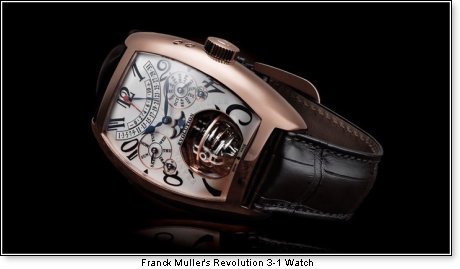
The Aeternitas Mega 4 – Lastly, the epitome of fine watchmaking comes to life with the collaborative efforts of Franck Muller and Pierre-Michel Golay's profoundly remarkable creation: the "Aeternitas Mega 4." With 36 amazing complications, 1,483 components, and record-breaking 99 jewels, the watch is defined as something of a "lost Ark," encoded with the entire history of true watchmaking at its greatest. Combining Muller's iconic Art Deco Cintre Curvex case with a cutting-edge complicated caliber, the Aeternitas Mega 4 fuses every single complication, dream, and passion of watchmakers since the conception of time.
In addition to the tourbillion, minute repeater, moon phase, and perpetual calendar, the greatest breakthrough of this watch comes with Golay's contribution of making the first wristwatch to succeed in implementing a grand et petite sonnerie using the profoundly difficult Westminster Chimes. It is a highly complex version of a minute repeater, with two additional gongs and hammers (four in total for each) capable of playing the Westminster's four note melody for the quarters in the hour (every 15 minutes). In addition to this, the incredibly complex perpetual calendar feature on the watch is created to accurately keep time for 1,000 years and beyond, correcting the error in changes to the calendar from continual leap years that offset the exact decimal 365.24219 days in a year. And finally, a particularly unique quality of the watch is the "equation of time" function, which provides the wearer an exact understanding of how long a day is based on varying solar days throughout the year (very few days possess exactly 24 hours). "With one look, you will always know if the day you experience possess less or more solar time, or whether you are in one of those four rare days when we have precisely 24 hours."
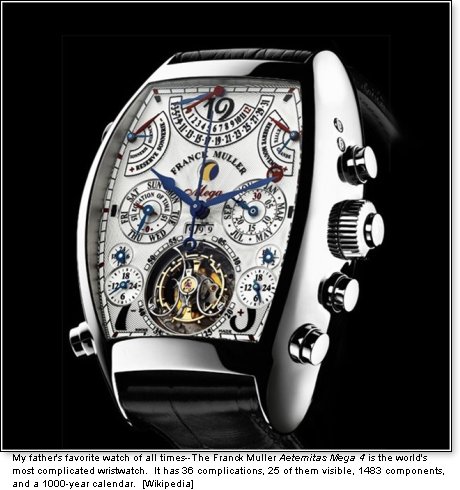
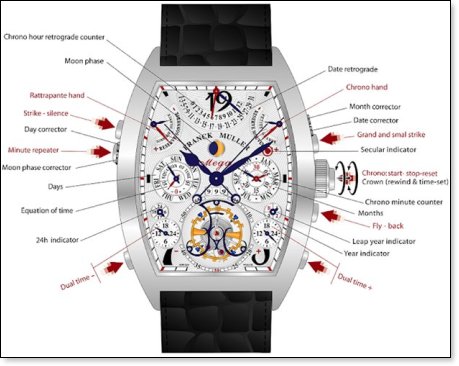
Conclusion – Franck Muller's inspirational genius
Truly, there exists no other watchmaker with the collective genius and prophetic foresight is the Franck Muller brand. With the combined minds of Franck Muller, Pierre-Michel Golay and Vartan Sirmakes, the world of watchmaking took on new meaning with revolutionary pieces capable of not merely telling time, but opening an expressive portal into the spirit of the wearer, allowing one to reveal their creative genius. Muller's watches transform the conventional way of how we perceive time, reintroducing ancient methods of deciphering time in completely new and revolutionary ways. His unconventional genius is a testament to the many avant-garde individuals who shaped entire eras to their particular brand of exceptionality and critical thinking; Renaissance men like: King Solomon, Alexander the Great, Leonardo DaVinci, Abraham Lincoln, Albert Einstein, and even Donald J. Trump. Muller is a man that has redefined the mysterious beauty of time for the modern age, introducing not only new mind-blowing concepts in timekeeping, but redefining the rules of how man governs time and how time shapes society in the modern age.
*N.B.: info based in part on the Spring 2018 edition of Revolution magazine.
© Stone Washington
January 31, 2019

"For the man, the watch is the single greatest self-expressive object he wears; it is his jewel and to be without a watch, for many men, is to be totally undressed."
"The greatest factor for us in relation to how slow or how quick time passes has to do with the enjoyment of time."
~Franck Muller
The origins of time and horology
Timekeeping and the basis of time is the core element in tracking human existence and universal events. It is the measurement of history: past, present, and future, establishing an indefinite precedent behind human progression in the World. At the center of time is the invention of the watch, the most useful and versatile method of accurately keeping time. Watches have undergone multiple transformations and upgrades since being officially conceived in the 16th century and have been derived from a series of antiquated methods of timekeeping. Below is a brief timeline containing many of the greatest innovations in modern timekeeping, from antiquity to modern day:
- Sundials – were first used by the ancient Babylonian empire for scientific and mathematic purposes in 1500 BCE.
- Water clocks – the first recorded use was in 6th century China, but some historians speculate it dating back to as early as 4000 BCE.
- Mechanical clock – is introduced in England in 1275 AD.
- Pocket watch – the first pocket watch was supposedly created by Peter Henlein in 1504, but the true inventor remains unknown. The first official pocket watch was crafted by an unknown maker in 1574, featuring a bronze depiction of Saint George slaying a dragon on the front and the Crucifixion on the back.
- Pendulum clock – originally conceived by Galileo Galilei in 1637, but officially introduced in 1656 by inventor Christian Huygens.
- Stopwatch – prominent French inventor Nicholas Rieussec files a patent for a "timekeeper or device to measure the distance traveled, called a seconds chronograph," first given to King Louis XVIII in tracking elapsed time for horse racing. This creation leads to the modern creation of the chronograph, or stopwatch.
- Wristwatch – First designed by the legendary watchmaker Abraham-Louis Breguet in 1812, who crafted a watch to fit on a person's wrist for Caroline Murat, Queen of Naples.
- Perpetual calendar & split-seconds hands – In 1868, Patek Phillipe introduces the first complications (sophisticated components of a watch) in the form of a perpetual calendar, capable of tracking the days for any given year, month, and day of month, while accounting for leap years, and a split-seconds hand, which keeps elapsed split seconds within seconds (a double chronograph).
- Atomic clock – the first Casium atomic clock, capable of keeping accurate time to within a few seconds every 100,000 years, is invented by Dr. Louis Essen of the National Physical Laboratory.
- Electric watch – the first electric watch powered by a battery is introduced in 1957 through the iconic American company, Hamilton.
- Quartz watch – The Japanese watch company, Seiko, launches the first watch powered by a quartz crystal.
- Computer watch – Seiko creates the first watches capable of computing data in 1980.

Watches act as portable spring-driven clocks, which were invented prior during the 15th century. Watches utilize a complex system of interconnected gears propelled by winding a mainspring, which transfers power to an oscillating balance wheel. The watch's escapement then releases the inner-wheels to inch forward a small amount during every swing of the balance wheel. The mainspring acts as the power source of the watch, the power of which is disseminated by the escapement which regulates every swing of the balance wheel; an advanced pendulum.
Despite the many innovative achievements and technological breakthroughs in timekeeping, no other watch company has achieved the greatest level of complications in watchmaking as Swiss watchmaker Franck Muller (1958 – ). Following the Quartz crisis, a period in the 1970's that led to economic upheavals and layoffs in mechanical watchmaking, Franck Mueller launched a company that would revolutionize modern watchmaking and breath newfound life into the elegant art of Swiss timekeeping. Muller, along with inventor Pierre Michel-Golay and Co-founder Vartan Sirmakes would introduce a new realm of timekeeping that broke the monolithic boundaries of tracing time for centuries, creating the first series of unprecedented complications in watchmaking.
This article will describe Franck Muller's greatest inventions and universal impact on essence of timekeeping, tracing inspiration from the leading watch manufactures: Patek Philipe, Audemars Piguet, Breguet and others, to create truly transformative timepieces that defy the norms of reality. Even today, Muller serves as an ambassador to inspiring those who think critically and defy the artificial boundaries of possibility, going above and beyond what is expected.
Biography: Franck Muller and the "Purity of Existence"
Franck Muller: a showman, technical prodigy, impresario and elusive genius was born in 1958 to an Italian mother and Swiss father. Muller was infused with a DNA of a masterful design acumen, aesthetic bravado and admiration for scientific invention that made him the ideal Italian watchmaker, combined with the dedicated precision and respect for traditional values that comprise the root of Swiss watch culture. Franck is prominent in his ability to reach back into the historic origins of watchmaking and from this create an all-new relevance to the mythical language of complications. His company has made an art out of reinventing the value of a watch's essence; its gearwheels, balance wheels, hairsprings, etc. for a new contemporary world. "What is clear is that without Franck Muller, watchmaking would not exist at the same level of cultural relevance as it does today" says watchmaking legend Phillipe Dufour.
Franck Muller often struggled in grade school, desperately seeking to gain his Father's approval. This until Muller approached his father one day and vowed to enter watchmaking school, declaring, "Father, I will finish, and when I graduate, it will be as the top student." Muller fulfilled his vow when, in 1977, at the age of 19, he graduated from watchmaking school in an accelerated program with top honors. "It was only when I became a watchmaker that I discovered what I was talented at, what God had put me on earth to do. And from the day I stepped into watchmaking school, I never scored anything less than a perfect mark." Unfortunately, Muller's father passed away soon after he was proud of his son's achievement.
In his practice, Muller is confounded by how sophisticated a watch operates, seeing as how when you break it down component by component, wheels, springs and all, its just pieces of metal. It is a miracle of ingenuity that a watch can operate at all and function flawlessly 24 hours a day, 365 days a year; creating something truly incredible. Almost immediately after leaving watch school, Muller had the dream of creating his own brand, seeking to "elevate this language of watchmaking to an even higher level of expression," he says, "I wanted to create an evolution that would unveil hidden truths about the way human beings express time." Muller would gain his first big break when he was provided a Rolex as a gift, but called the watch too simple upon wearing it. So, he decided to transform the watch into a perpetual calendar with retrograde indications, linear displays on the watch that reveal functions like: day/night indications and power reserve. Upon completing it, Muller signed the watch "Rolex and Franck Muller" and presented it to the top Rolex engineers who, after several days, ultimately rejected it because they abided by the Rolex philosophy was to produce the simplest but most reliable watch possible.
But Muller would capitalize on this venture by selling the watch for 10,000 Swiss francs to a gentleman named Francis Meyer, the son of an extraordinary pocket watch collector. The watch would break the record for being the most expensive steel watch sold just two years after Muller had sold it, passed onto an Italian distributer of watches in Monaco for 400,000 Swiss francs.
"The beginning of my story in watchmaking coincided precisely with the end of traditional high watchmaking," Franck explains, "previous to the modern age, watches were made almost entirely by hand. The designs for the watches began entirely within the minds of the watchmakers." There were no complex computer simulations to test complicated mechanisms, creating an enormous risk for each watch made. This until the watchmaking world was reinvented following the Quartz crisis in the 1970s. While computers helped create complex parts and allowed for rapid prototyping, it also took something away from watchmaking: it robbed a bit of the inexpressible human spirit and diminished in some way the measure of soul that went into each watch. The Quartz crisis counteracted the time-honored tradition of the watchmaker, who pitted his intellect, manual dexterity and creative internal fortitude against the unchanging laws of physics. Man could no longer bend time to his will in an age of automation.

"Every great watchmaker had his secrets, his method to make time obey him, to activate the heartbeat inside the watch," according to Muller, "my secret was that I could repeat what I saw quite eastly from memory." Laboring under the tutelage of Svend Anderson, Muller recounts how strict his master was when he would examine Muller's mechanisms modeled after Anderson's work, examining it with a 3xloupe to spot any imperfections. If there was even the slightest, he would very strictly throw the part away. Under Anderson, Muller labored tirelessly, absorbing rich information and plunging into the past to see how old masters solved the age-old riddles of measuring time.
Franck would reach deep into horology's past and transport one of its most technically sophisticated innovations into his first wristwatch collection. This came through the reinvention of the tourbillion for wristwatches by Muller, an invention first produced by A. L. Breguet to improve precision in watchmaking. While Breguet is one of the oldest and greatest watch manufacturers, Muller surpassed the company's conventionality when turning the tourbillion into a device that captures and expresses emotion. Patented in 1801, the tourbillion places all the complex regulating components of the watch – including the parts that form its: escapement, hairspring, and balance wheel – inside a cage that rotated on its own axis. This cage averaged out the positional errors including how gravity inaccurately affects the movement of the hairspring when a pocket watch is left in the vertical position.
"Today, these watches are more like works of art which demonstrate what is possible through human craftsmanship, and engage the user on the emotional level," Muller states, "People were living life to the fullest and they wanted new symbols of success, and the tourbillion was it." In devising his company, Muller embarked on creating something wholly unique that the world hadn't seen before; something daring but also horologically legitimate in the eyes of the most refined collector. Muller went on to create the World's first minute-repeater tourbillion, a complicated mechanism capable of chiming the hours and minutes in a watch, eventually moving to create something even more difficult: the world's first tourbillion with split-seconds chronograph.
Muller, along with his branding associate Vartan Sirmakes and watchmaker Pierre-Michel Golay went on to dominate the world of watchmaking, from the company's rise in 1984 through the 1990s. Some of its most famous early adaptors of the brand were: Gianni Versace, Elton John, and Jackie Chan. In the final section, we will look at some of the greatest horological breakthroughs that Muller made in watchmaking.

Mueller's Revolutionary Complications
The Giga Tourbillion – Dubbed "The Colossus of Genthod" after "The Colossus of Rhodes" statue, one of the Seven Wonders of the Ancient World that was made in honor of the unconquerable city of Rhodes. This, when Alexander the Great's three greatest generals: Ptolemy, Seleucus and Antigous tried to and failed to besiege the city for a year. The "Colossus of Genthod" is a living testament to the daring courage and technical mightiness of the most successfully independent watchmaker in contemporary horology. So why the name Giga Tourbillion? This due to the entire bottom half of the watch being dominated by a tourbillion regulator so large that "the arms of its cage threatened to block out the rays of the sun," according to Vartan Sirmakes. "You can literally imagine gravity, which the tourbillion was created to defeat, whimpering like a scared dog in deference to the sheer monumentality of the Giga Tourbillion's 20 mm-diameter cage. Oscillating within this cage is a golden behemoth of a balance wheel measuring 16mm in diameter," declares Jean-Pierre Golay, "we are really at the limit of what we are capable of creating, even with the most advanced technology possible."
Crazy Hours – At first glance, the "Crazy Hours" watch appears to be a random jumble of colorful numbers, all in different places than they should be. But there is a method to the madness behind Mueller's design, as the hour hands leap around the dial in accordance to the set time (from 1-12) but jump five places instead of one to the next hour, while the minute hand functions normally. To simply call Crazy Hours a watch would be a disservice, as it is more of an artform; a vehicle for emotional expression and statement of personal philosophy. "Time was an invention of man to organize society so that social discourse and business could take place," Muller explains, "but we've become so encoded that we are moving mindlessly from one moment to the next, never reveling in the present to truly enjoy the experience. Crazy Hours had to be a statement that you could do what you want, whenever you want. In Crazy Hours there appears to be no sense as to what hours come next, and so, you are compelled to focus on the moment you are in." It is a peculiar watch meant to abstract, deconstruct, and reconfigure time with the intent to shock and delight the owner.

Master Banker – As Muller's brand began to grow, one of the greatest challenges he faced was being able to suit the needs of the contemporary consumer. The modern businessman or traveler is constantly shifting time zones and going from one place to another. Muller dreamed of a watch that acted as a horological Prometheus, bringing light to darkness and order to chaos. In an objective to illuminate the world, Franck Muller devised one of his most legendary timepieces: the Master Banker. Muller realized the idea through a close banker friend of his, Paul Tange, who explained his philosophy for modern business thusly, "The world has changed forever. When I wake up and I look at my watch, I want to immediately know when the market opens. Because the time it takes me to figure out the time, I could have made or lost a fortune," Tange states. After a great deal of planning, Muller devised a watch that harnessed three time zones in one, capable of telling the time in other cities across the World. Whether in New York, London, or Tokyo, the wearer is able to adjust the time befitting of a busy global schedule.
Secret Hours – Muller now delves into the human psyche to uncover truths about the way human beings perceive time. Imagine a watch that at first glance seems to be mired in contradiction; stuck in an immovable position with both the hours and minutes hands locked at 12 o'clock while the seconds hands continuously move as if the watch is under power. But the trick to this watch is that it only provides you the time when you feel like knowing it. Simply activate the pusher on the crown and the watch hands immediately jump to the correct time. Muller sought to create a watch that provides you with the proper time when you need to know it, while at the same time not imposing the burdensome reminder of continuous time passing by. "It is the only watch a civilized and truly elegant man should wear on his vacation," Mueller states. The watch is extraordinarily complicated from within, having two-split seconds chronograph heart cams that are attached to the respective hour and minute wheels, allowing time to be constantly traced by the watch while the hands instantaneously leap to the proper time without skipping a beat.
The Revolution 3-1 – "The Revolution 3-1" is the first triple-axis tourbillion ever devised in watchmaking, devised by Muller and Golay, complete with a perpetual calendar. "There is something very beautiful about witnessing this complex turning of the tourbillion on three axes, and then to have the empirical functionality of the perpetual calendar," says Golay. The tourbillion rotates independently of the rest of the watch in a self-contained cage, with each axis rotating on a different time cycle (one-hour, eight minute, and 60 second).

The Aeternitas Mega 4 – Lastly, the epitome of fine watchmaking comes to life with the collaborative efforts of Franck Muller and Pierre-Michel Golay's profoundly remarkable creation: the "Aeternitas Mega 4." With 36 amazing complications, 1,483 components, and record-breaking 99 jewels, the watch is defined as something of a "lost Ark," encoded with the entire history of true watchmaking at its greatest. Combining Muller's iconic Art Deco Cintre Curvex case with a cutting-edge complicated caliber, the Aeternitas Mega 4 fuses every single complication, dream, and passion of watchmakers since the conception of time.
In addition to the tourbillion, minute repeater, moon phase, and perpetual calendar, the greatest breakthrough of this watch comes with Golay's contribution of making the first wristwatch to succeed in implementing a grand et petite sonnerie using the profoundly difficult Westminster Chimes. It is a highly complex version of a minute repeater, with two additional gongs and hammers (four in total for each) capable of playing the Westminster's four note melody for the quarters in the hour (every 15 minutes). In addition to this, the incredibly complex perpetual calendar feature on the watch is created to accurately keep time for 1,000 years and beyond, correcting the error in changes to the calendar from continual leap years that offset the exact decimal 365.24219 days in a year. And finally, a particularly unique quality of the watch is the "equation of time" function, which provides the wearer an exact understanding of how long a day is based on varying solar days throughout the year (very few days possess exactly 24 hours). "With one look, you will always know if the day you experience possess less or more solar time, or whether you are in one of those four rare days when we have precisely 24 hours."


Conclusion – Franck Muller's inspirational genius
Truly, there exists no other watchmaker with the collective genius and prophetic foresight is the Franck Muller brand. With the combined minds of Franck Muller, Pierre-Michel Golay and Vartan Sirmakes, the world of watchmaking took on new meaning with revolutionary pieces capable of not merely telling time, but opening an expressive portal into the spirit of the wearer, allowing one to reveal their creative genius. Muller's watches transform the conventional way of how we perceive time, reintroducing ancient methods of deciphering time in completely new and revolutionary ways. His unconventional genius is a testament to the many avant-garde individuals who shaped entire eras to their particular brand of exceptionality and critical thinking; Renaissance men like: King Solomon, Alexander the Great, Leonardo DaVinci, Abraham Lincoln, Albert Einstein, and even Donald J. Trump. Muller is a man that has redefined the mysterious beauty of time for the modern age, introducing not only new mind-blowing concepts in timekeeping, but redefining the rules of how man governs time and how time shapes society in the modern age.
*N.B.: info based in part on the Spring 2018 edition of Revolution magazine.
© Stone Washington
The views expressed by RenewAmerica columnists are their own and do not necessarily reflect the position of RenewAmerica or its affiliates.
(See RenewAmerica's publishing standards.)


















